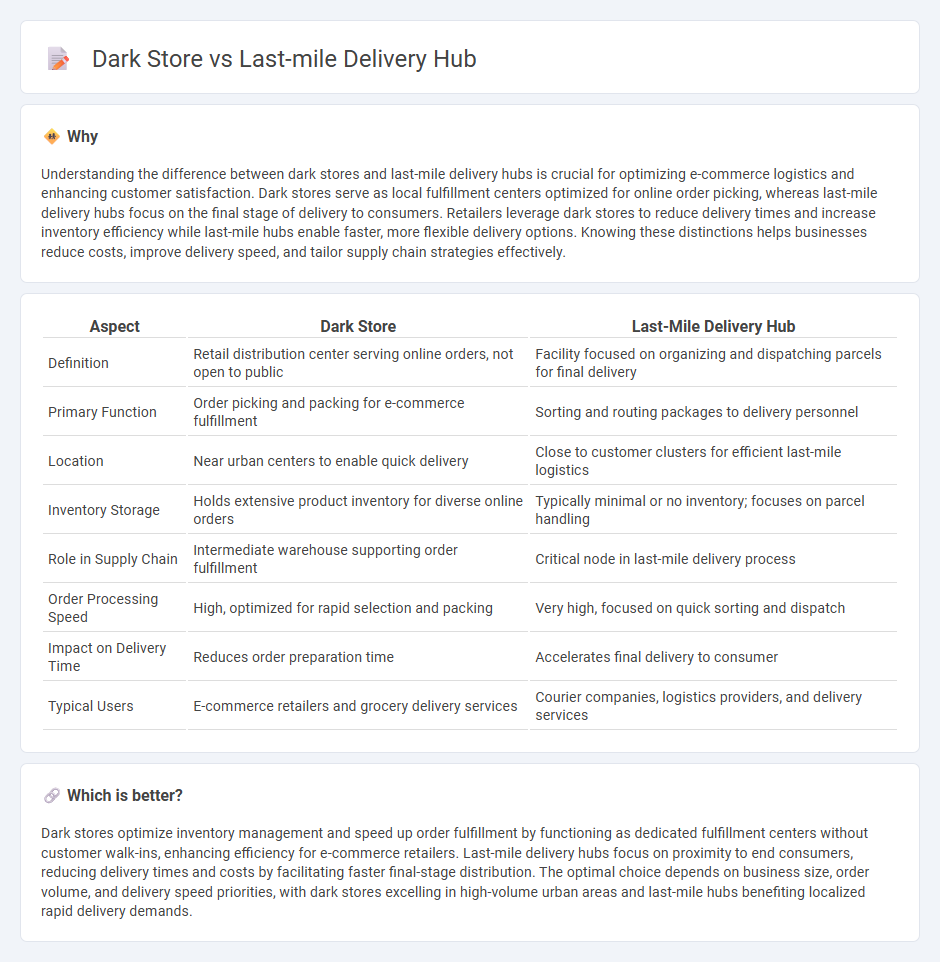
Dark stores function as inventory-only retail spaces optimized for online order fulfillment, streamlining the picking and packing process to enhance speed and accuracy. Last-mile delivery hubs serve as strategically located distribution centers designed to expedite the final leg of delivery, reducing transit times and improving customer satisfaction. Explore deeper insights into how these two models reshape modern commerce logistics.
Why it is important
Understanding the difference between dark stores and last-mile delivery hubs is crucial for optimizing e-commerce logistics and enhancing customer satisfaction. Dark stores serve as local fulfillment centers optimized for online order picking, whereas last-mile delivery hubs focus on the final stage of delivery to consumers. Retailers leverage dark stores to reduce delivery times and increase inventory efficiency while last-mile hubs enable faster, more flexible delivery options. Knowing these distinctions helps businesses reduce costs, improve delivery speed, and tailor supply chain strategies effectively.
Comparison Table
| Aspect | Dark Store | Last-Mile Delivery Hub |
|---|---|---|
| Definition | Retail distribution center serving online orders, not open to public | Facility focused on organizing and dispatching parcels for final delivery |
| Primary Function | Order picking and packing for e-commerce fulfillment | Sorting and routing packages to delivery personnel |
| Location | Near urban centers to enable quick delivery | Close to customer clusters for efficient last-mile logistics |
| Inventory Storage | Holds extensive product inventory for diverse online orders | Typically minimal or no inventory; focuses on parcel handling |
| Role in Supply Chain | Intermediate warehouse supporting order fulfillment | Critical node in last-mile delivery process |
| Order Processing Speed | High, optimized for rapid selection and packing | Very high, focused on quick sorting and dispatch |
| Impact on Delivery Time | Reduces order preparation time | Accelerates final delivery to consumer |
| Typical Users | E-commerce retailers and grocery delivery services | Courier companies, logistics providers, and delivery services |
Which is better?
Dark stores optimize inventory management and speed up order fulfillment by functioning as dedicated fulfillment centers without customer walk-ins, enhancing efficiency for e-commerce retailers. Last-mile delivery hubs focus on proximity to end consumers, reducing delivery times and costs by facilitating faster final-stage distribution. The optimal choice depends on business size, order volume, and delivery speed priorities, with dark stores excelling in high-volume urban areas and last-mile hubs benefiting localized rapid delivery demands.
Connection
Dark stores act as localized fulfillment centers designed exclusively for online order preparation, streamlining inventory management and reducing delivery times. Last-mile delivery hubs function as distribution points near key consumer areas, enabling rapid dispatch of goods to final customers. The integration of dark stores with last-mile delivery hubs optimizes supply chain efficiency by shortening delivery distances and accelerating order fulfillment in the commerce ecosystem.
Key Terms
Fulfillment Center
A last-mile delivery hub is a strategically located facility that expedites shipping by storing and dispatching products closer to end customers, optimizing delivery times and reducing transit costs. In contrast, a dark store functions as a fulfillment center designed exclusively for online orders without traditional retail, enabling efficient inventory management and rapid order processing. Explore the key differences and benefits of each facility type to enhance your e-commerce fulfillment strategy.
Inventory Management
Last-mile delivery hubs prioritize rapid order dispatch with minimal on-site inventory, leveraging proximity to urban centers for efficient delivery within hours. Dark stores maintain comprehensive stock levels, functioning as specialized warehouses that streamline inventory management and order fulfillment without customer foot traffic. Explore the distinct inventory strategies of last-mile delivery hubs and dark stores to optimize supply chain efficiency.
Pick-up Point
Last-mile delivery hubs and dark stores both enhance urban logistics but differ in operational focus; last-mile hubs prioritize efficient parcel distribution near consumers, whereas dark stores function as localized inventory centers designed for rapid order fulfillment. Pick-up points at last-mile hubs offer customers convenient, contactless parcel collection, reducing delivery times and improving flexibility, while dark stores primarily support direct-to-door deliveries without a retail storefront. Explore further to understand how these models reshape e-commerce fulfillment and urban delivery strategies.
Source and External Links
What is a Last-Mile Delivery Station? - Wise Systems - A last-mile delivery station is a local hub that receives packages from larger distribution centers, sorts them, and dispatches them to final delivery locations, improving delivery speed, accuracy, and customer experience by being closer to densely populated areas.
Central Hub and Last Mile Depot Solutions - FORTNA - A last-mile delivery hub consists of a central hub where parcels are sorted and a last mile depot where parcels are delivered directly to consumers, forming the final step in the delivery supply chain.
Last Mile Delivery Solutions | Ryder Final Mile Logistics - Last-mile delivery hubs, such as those operated by Ryder with a network of 158+ multi-client hubs, provide optimized final mile logistics with options including same-day delivery, white glove service, and advanced technology integration for efficient customer fulfillment.
 dowidth.com
dowidth.com